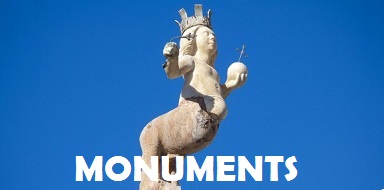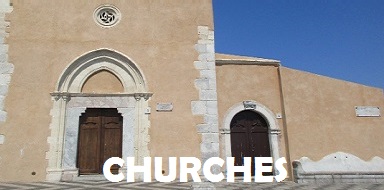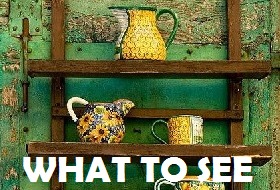Discover what to see in Taormina and Its surroundings
GOING THROUGH THE TOWN
PORTA MESSINA AND PORTA CATANIA
In ancient times Taormina was protected by a circuit of walls with a triple fortification system, which from the north on the side looking towards Messina continued in a north-east direction and ended in the west on the side looking towards Catania.
Traces of these walls can still be seen today not only in the centre of the town where the clock-tower stands, but also at the two furthest ends of the town where there are two entrances, commonly called Porta Messina and Porta Catania.
Porta Messina, restored at the beginning of the 19th century, was named Porta Ferdinanda when it was opened in 1808 by Ferdinand IV of Bourbon.
There is a tablet commemorating the occasion on the top of its arch. Porta Catania on the other hand is the end result of various changes and restorations, the last of which were performed in 1440 by the Aragonese. The Aragonese coat-of-arms sculpted in relief above the city coat-of-arms in the center on the top part of the gate.
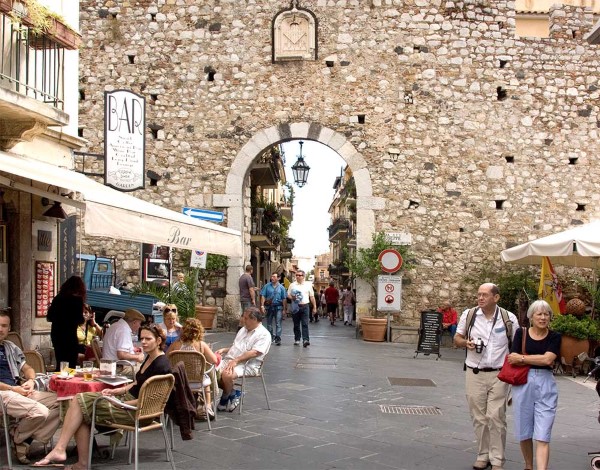

GOING THROUGH THE TOWN
UMBERTO STREETS
The main street of Taormina is named after Umberto I of Savoy, king of Italy from 1878 to 1900. Corso Umberto I was an integral part of the ancient Valeria street which, crossing the city and then descending towards the sea, connected Messina to Catania.
Bordered to the north by Porta Messina and to the south by Porta Catania, the Corso has structures and buildings belonging to styles from different eras, from the Arab to the Norman, from the Gothic to the Baroque.
The Greek-Roman monuments have been replaced by new buildings, so the temple of Jupiter Serapis has given way to the Church of S. Pancrazio and the Church of S. Caterina was born on the remains of the Odeon.
The presence of palaces and churches along the Corso and its surroundings have transformed the ancient Via Valeria into today’s historic center, animated by the shops and typical restaurants that welcome visitors from all over the world every day.
GOING THROUGH THE TOWN
THE FOUNTAIN IN PIAZZA DUOMO
The Fountain in Piazza Duomo is the Taormina’s emblem. This Barocco style fountain, built in 1635, is in Taormina marble with three concentric steps at its base. On each of the fountain’s four sides there are some small columns supporting basins; mythological ponies overlook the basins and fountain water flows out of their mouths.
The eastern base of this large fountain contains a fourth basin, larger than the others but no longer used since it was a watering-place for animals. There is a smaller octagonal basin in the middle of the fountain base with four putti resting on it; on the east side, two of these putti hold two smaller putti each, forming the base of an octagonal basin decorated with three seals showing their heads and tails.
Three mythological characters resembling Tritons stands in the middle of this latter basin with their arms crossed over their heads so as to support another basin decorated in low-relief; a round base inside this basin holds a basket of fruit on the top of which stands Taormina’s coat-of-arms.
The town’s coat-of-arms normally pictures a male centaur but, in this case, it was turned into a female centaur and a two-footed one at that.

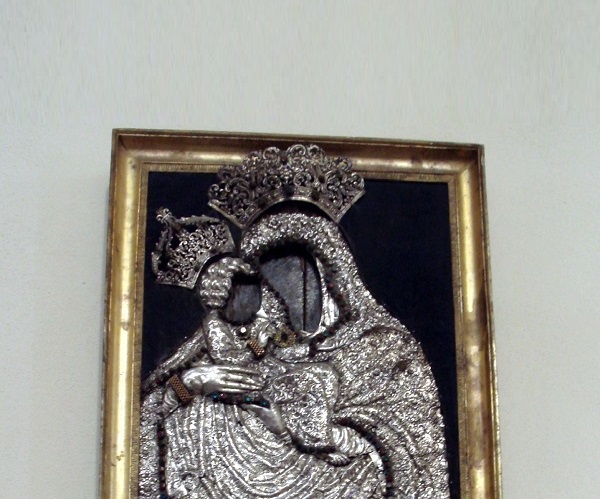
GOING THROUGH THE TOWN
THE BYZANTINE MADONNA
Byzantine Madonna or “non hand-made” Madonna is now kept in the Cathedral of Taormina. This Madonna was found inside an old well and was probably placed there to save it from the many invasions and pillaging that went on during the Arabian era, although tradition has it that it was left there by the angels.
That is why it is called the “non hand-made” Madonna, meaning not made by human hands. It is an oil painting on panel covered with a layer of silver and semi-precious stones. Unmistakably belonging to the Byzantine era, the painting was dedicated to Holy Mary of the Greeks.
The faces of the Madonna and Jesus are barely visible but this is because it is said that it was found, in Badia Vecchia and that whoever saved the picture did so to save it from fury of the Arabs when they took Taormina.
Worthy of note is the inscription next to the image, dated January 1693. A dedication and a prayer to the Virgin by the Jurors for having spared the city, from the nefarious earthquake that destroyed many cities in eastern Sicily including Catania, Ragusa and Noto.
GOING THROUGH THE TOWN
THE SAN DOMENICO
This Dominican monastery, now the San Domenico Hotel, was the third monastery in Taormina. Its origins and history are related to Damiano Rosso, a Dominican friar who was a descendant of the Altavilla family and Prince of Cerami.
After becoming a friar, he donated all he owned to the Dominican order in 1430. His antique mansion was therefore turned into Taormina’s Dominican monastery. The “San Domenico” was the first or perhaps the only castle existing in Taormina during the middle ages.
Some centuries later the estate was given back to Damiano Rosso’s heirs who turned it into a hotel. The only part of the former monastery to remain open to worship was the chapel which, however, was destroyed by bombings on July 9, 1943. The congress hall of the hotel was built on the ruins of the chapel, conserving the remains of the minor altars.
The bombings did not damage the rest of the hotel nor the 50 cells which were later turned into luxurious hotel-rooms. The beautiful cloister and magnificent park, which overlook the sea and have a view of Mount Etna, are the most charming parts of the hotel.
A second wing, added to the hotel in the 1930s, harmoniously reflects the architectural style of the rest of the building with many authentic art treasures as well as sacred vestments and vessels and paintings by well-known artists.
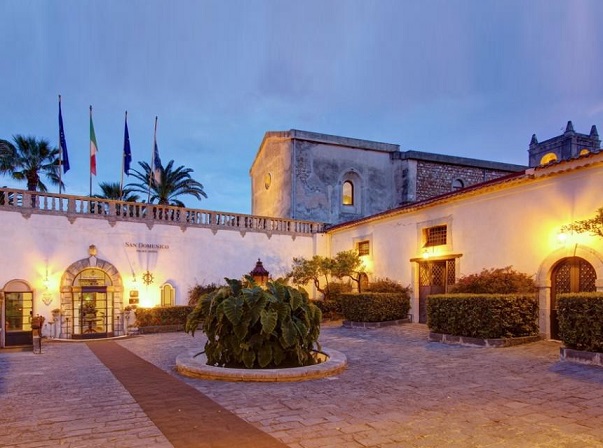

GOING THROUGH THE TOWN
THE CLOCK TOWER
The clock-tower acts as an entrance gate to the part of the town that historians call “the 15th century area”. Dating back to the 12th century, the tower was razed to the ground during a French invasion under Louis XIV in 1676.
What can be admired today is a reconstruction by the people of Taormina in 1679, who added a large clock to the tower. Studies carried out over the years, however, have shown that the foundations of the tower in large square bricks of Taormina stone date back further than the first construction date of the tower.
It can therefore be supposed that the first tower was built on the ruins of an older defense wall which would have dated back to the origins of the town, in other words the 4th century B.C.
GOING THROUGH THE TOWN
THE GYMNASIUM – THE NAUMACHIE
The Gymnasium in Taormina was in the area called “Giardinazzo”, where the so-called Naumachiae ruins can still today be seen. The “Gymnasium” was usually a construction with a rectangular perimeter, surrounded on its four sides by an arcade supported by columns.
The clearing in the centre was for games and gymnastical exercises. In fact, it was the place where young men were educated from both a civil-religious and operative point of view. The athletes who participated in the Olympic Games were trained in the Gymnasia.
In Taormina the only remaining wall of the antique Gymnasium rests on a double row of well-cut steps in Taormina stone which form the base of the wall. There are 18 niches with round arches and 18 other smaller rectangular niches.
The name “Naumachiae”, from Greek meaning “sea battle”, improperly given to these ruins is probably attributable to the fact that there is a large reservoir on the remaining wall, which used to be a water supply for the Gymnasium and a reserve for the whole town.

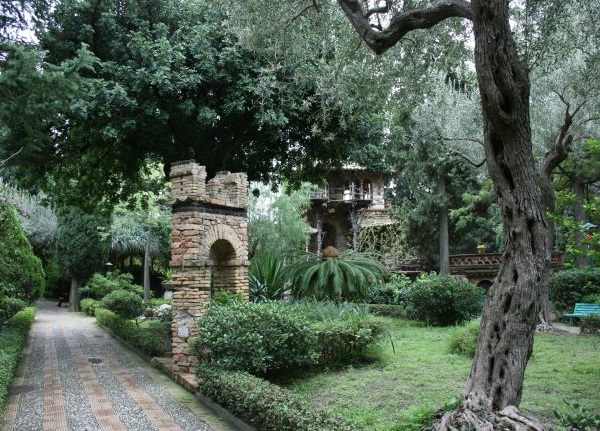
GOING THROUGH THE TOWN
THE PUBLIC GARDENS
The town gardens, named after the Duke of Cesarò who was a representative of Taormina’s constituency when they were made, were donated by the Cacciola-Trevelyan family during the 1920s. Inside, there is a thick vegetation and a typically Mediterranean array of hedges and flower-beds with cobbled paths which lengthwise connect the almost three hectares of park.
An avenue lined with olive-trees in memory of the fallen during various wars runs among precious trees of various species, some of which are rare and extraordinarily beautiful. In the centre and on the north-east end of the gardens, there are some characteristic pagoda-style towers with arabesque designs, made of bricks and edged with lavic pumice-stone.
Florence Trevelyan, an English nobelwoman, had these towers built so as to study the birds since the was a keen ornithologist. Relics from the two World Wars are on show in a few clearings and a war monument to the fallen can be seen near the natural “Teatro di Verzura” (Greenery Theatre).
GOING THROUGH THE TOWN
THE ARABIAN NECROPOLIS
Just a few hundred metres away from the town’s northern gate, along the road that from Capo Taormina leads up to the centre of the town, the Arabian necropolis, even though it is defined as Byzantine by many, is rare evidence of the “daily” aspects of that period.
It is thought to have been created during the 10th and 11th centuries and is defined as a columbary necropolis due to the fact that the cells are symmetrical and situated one on top of the other.
What can be seen today are the remains of a much larger construction which went on towards the north-eastern part of the town centre between the current necropolis site and the lower Church of St. Peter outside the town walls.

.










